What I’ve Been Playing (Q3) 2020
Thoughts and impressions on the games I played during Q3 of 2020, including Raji: An Ancient Epic, Huntdown, Xeno Crisis, The Last of Us: Part II and more.
 UnexpectedGames
UnexpectedGames
Just a friendly bear who works in financial reporting that would rather be playing, writing or talking about video games. https://twitch.tv/unexpectedenemy
Thoughts and impressions on the games I played during Q3 of 2020, including Raji: An Ancient Epic, Huntdown, Xeno Crisis, The Last of Us: Part II and more.
At the time of writing this, I’ve been working from home since March, 2020. Outside of doctor/dentist appointments and other essential outings, I’ve only seen three of my friends on two separate occasions, outside and at a distance, since the start of this mess. While I’m fortunate/grateful to have sustained my job of eight years through all of this, I’ve only really seen the same three to four rooms for the majority of the year and like for many people, it’s taken its toll on me. We’re nine months into this pandemic in the states and there’s no vaccine yet people still refuse to deny science and opt not to wear masks in public. So, I’ll continue to play and write about video games in hopes that our new administration will lead us back onto some sort of path to normalcy. Maybe we’ll get our lives back one day, but I’m not optimistic it’ll be anytime soon. That’s where I’m at. So, here’s some isolated ramblings on the games I’ve played during the months of July through September.
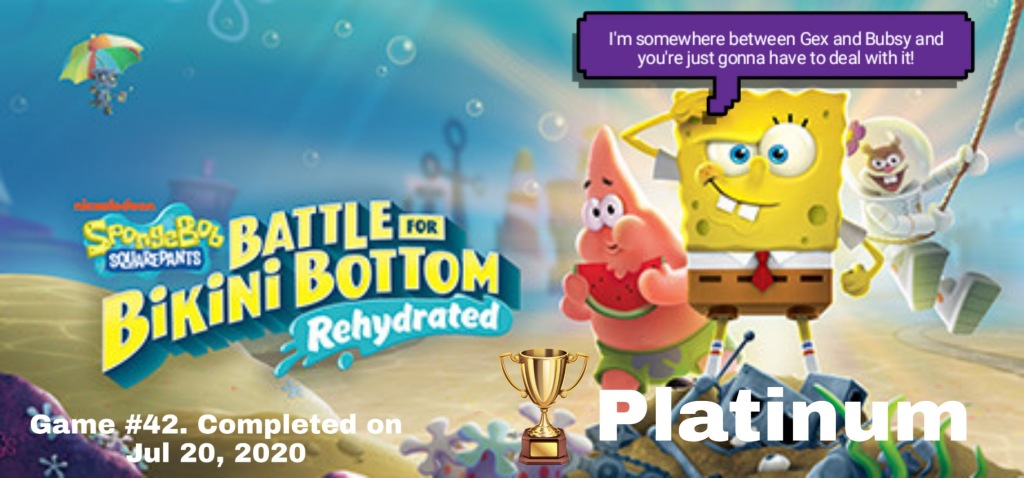
Like most kids from the 90s, I watched a whole lot of Nicktoons on Nickelodeon. Cartoons like Rugrats, Doug, Ren & Stimpy and Rocko’s Modern Life were my bread and butter. By the late 90s, however, I started to drift away from Nickelodeon, so I missed the boat on shows like SpongBob SquarePants, which wasn’t necessarily for my generation in all fairness. SpongeBob SquarePants: Battle for Bikini Bottom: Rehydrated (Bikini Bottom), originally developed by Heavy Iron Studios but now by Purple Lamp Studios, is a remaster of the 3D platformer released back during the PS2/GC/Xbox era. Despite being an avid 3D platformer fan for the majority of my life, I never played this one back in the day. Bikini Bottom was considered one of the better licensed 3D platformers for its time, so I figured why not give the remaster a shot?
Despite never watching a single episode of the cartoon, I quite enjoyed my time spent with the game. I quickly understood why these characters were so beloved, even though the video game version of SpongeBob, with his one-liners and unfunny quips, felt like a cross between Gex and Bubsy (which isn’t necessarily a compliment). Bikini Bottom certainly gave me a slice of what to expect from the show, if I were ever to give it a whirl (which I probably never will at this point). The game itself is a well-made 3D platformer riding the success of games like Super Mario 64, Banjo-Kazooie, Jak and Daxter: The Precursor Legacy and other objective-based collect-a-thons. There are multiple playable characters each with their own unique abilities, which allow them to complete particular platforming/puzzle sequences scattered about each level. SpongeBob, for example, can turn into a ball and roll around obstacles while Patrick, your best friend who happens to be a starfish, can carry heavy ice blocks and freeze pools of water.
Like any good 3D platformer, there’s hundreds of items to collect and the level design, although a bit rough around the edges at times, is relatively competent. Something the game could have done a better job of, however, was actually selling the fact that, I don’t know, these characters live under the sea? I kept having to remind myself that they’re technically underwater (especially once I discovered a squirrel-like character, suited in a diving suit, who lives in a glass bowl at the bottom of the ocean – to keep the water out, or course). I think it would have been interesting if your characters were heavy and moved with more weight, but I don’t think that’s how the show works and it certainly wouldn’t have made the game any more enjoyable. I completed the game with everything collected and the Platinum trophy earned. Although I liked the game enough to complete it in its entirety, I don’t see myself ever playing this again in the future.
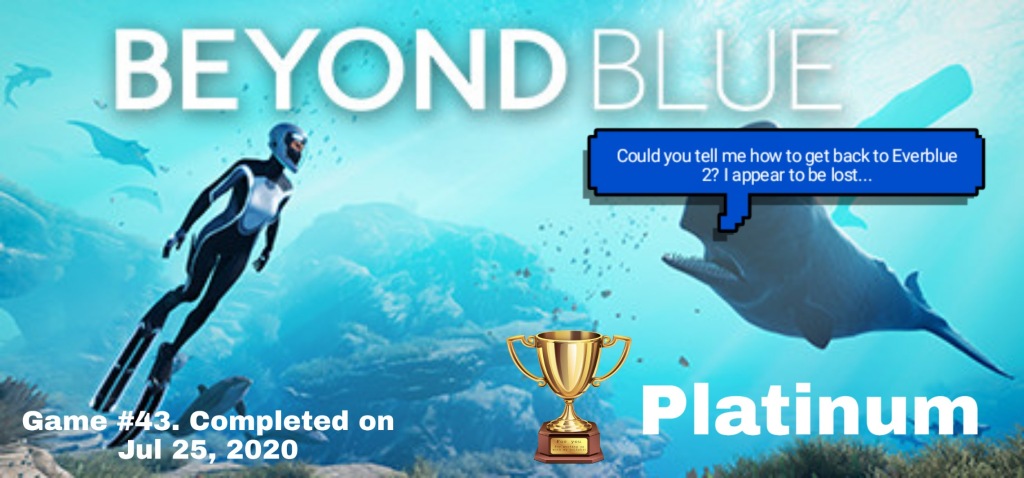
Speaking of games about being under the sea, E–Line Media’s Beyond Blue is a super relaxing, documentary-style sea exploration game where you play as a young woman following a family of sperm whales. What’s interesting about the story is that the main character’s only remaining family is a sister and an aunt (who also happens to be unwell/sick) which draws a parallel to the family of whales she’s studying. I’ve played games like this before in the past; both Everblue 2 and Endless Ocean, for example, were also deep sea diving games with far more interesting mechanics and depth. Beyond Blue, however, is a much shorter, more relaxed experience with less “things to do”, which isn’t necessarily a bad thing.
The game itself doesn’t ask much from the player, however. You’ll simply swim around a handful of enclosed areas, following pings from buoys and scanning (a lot) of sea life. Think Metroid Prime, but somehow more boring/tedious. With that said, given the state of the world, I found Beyond Blue to be somewhat of a therapeutic experience during my summer months spent in quarantine. The game surprisingly has an all-star cast too, including talents such as Mira Furlan (Lost, Babylon 5), Hakeem Kae-Kazim (Black Sails, Hotel Rwanda), and Ally Maki (Toy Story 4). The audio mixing was way off, though. Most of the time, it felt like the characters spoke way too low while the music that played in your submarine sounded overbearingly loud. Speaking of the soundtrack, you could also unlock music from Miles Davis, The Flaming Lips and The Edisons.
Similar to their previous game, Never Alone (Kisima Ingitchuna), the developers partnered with BBC Studios (creators of the acclaimed Blue Planet II), OceanX Media, and other ocean scientists to record mini-documentary videos. Just like with Never Alone, I definitely learned a thing or two about the ocean that I didn’t know before. I’ve really enjoyed these educational-driven experiences and I’m hoping the developer continues to do titles like this moving forward. I completed the game with the Platinum trophy and although I enjoyed my dive into the ocean for a few days, I don’t think I’ll take this one for another swim anytime soon.
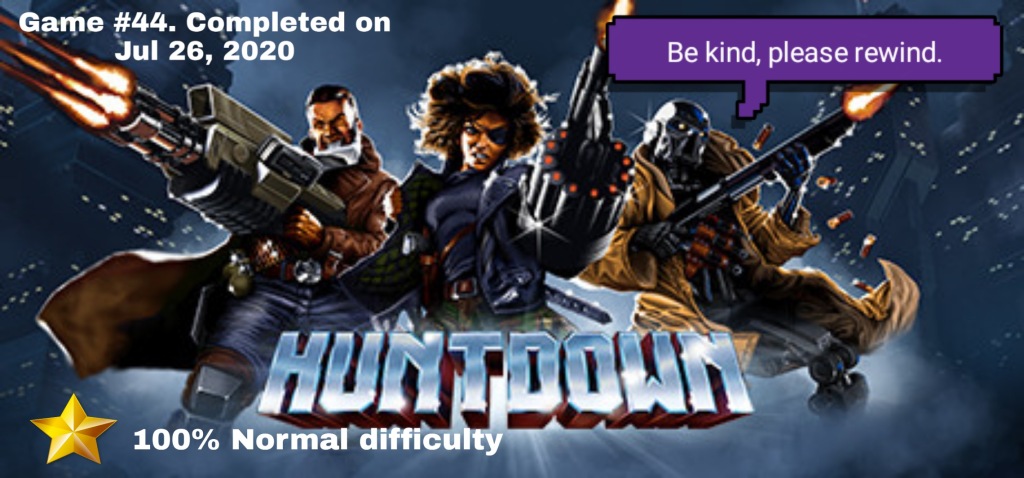
Huntdown is one of the best 2D Run N’ Gun Contra/Metal Slug-likes I’ve ever played. Developed by Easy Trigger Games, Huntdown is set in what appears to be an 80s-inspired, cyberpunk fueled, post-apocalyptic world, where you play as one of three bounty hunters who are quite literally tasked to hunt-down numerous gangs/crime syndicates (all of which are stereotypical yet deliciously themed). Each mercenary plays mostly the same; they can all run, jump and shoot, but they also come equipped with unique side-weapons.
Nowadays, it feels like there are hundreds of 2D side-scrollers released in a month, but Huntdown certainly stands above the rest (I actually preferred it to 2019’s Blazing Chrome – another highly recommended Run N’ Gun shooter). The game’s just oozing with style and it’s overall presentation is one worth noting. In one stage, for example, a deranged hockey team has overtaken a part of the city. In the final area, as you approach the leader/boss, you slowly ride an elevator upwards to a stadium where you can hear the boss giving his speech in the background set to the backdrop of a roaring crowd. As you’re ascending the elevator, flickering lights adorn the sides of buildings and you can even see a shady group of thugs sitting at a dimly lit table – perhaps plotting their next move against the town. There are small moments and details like this everywhere and it’s what sets the game apart from any of its contemporaries.
The game’s relatively short, but it’s highly replayable, too. There are secret caches to collect and medals for killing a certain amount of enemies in each stage while not dying. There are even multiple difficulties, but I only managed to complete the game at 100% on Normal – which was challenging enough. If you were only going to checkout/play one retro-inspired Run N’ Gun this year, Huntdown is it. I’ve got a target locked on these developers and I believe they’re going to do great things in the future.
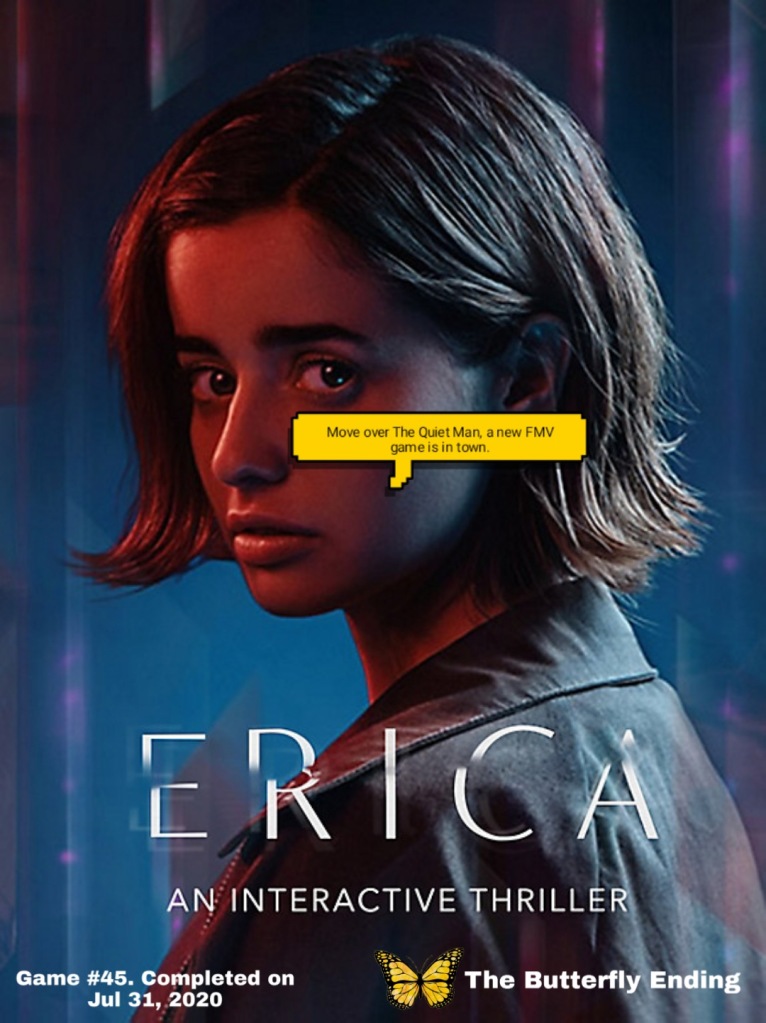
Erica is a FMV-based game by Flavourworks. If you’re unfamiliar with the age-old genre, they’ve been around for quite some time and they’ve been making a resurgence as of late. Limited Run Games, an independent publishing company that releases digital-only titles physically, has had their hands on the relevancy of these types of games lately, for example. Games like Night Trap, Corpse Killer and Double Switch were notorious for their full-motion video, horrible interfaces and cheesy, almost soft-core porn levels of acting. Today, they’re much more respectable and Erica is definitely one of the more interesting and well-made ones.
Erica is essentially a murder mystery story where you play as a young woman who’s attempting to unravel her past. In order to find the truth behind her parent’s death, she partners up with a detective to uncover the mysteries surrounding her family’s legacy. The main character (Erica) is also haunted by nightmares and her discoveries lead her to the occult. A lot of the game takes place in a mental asylum (where her parents worked, I think?). The game itself allows for some light puzzle-solving/interaction through the touch pad (or you can use the dedicated phone app, which worked quite well). The game’s beautifully shot, well-acted and it’s just about standard movie-length (2 hours or so?), but I honestly couldn’t tell you what happened during the time I spent watching the story unfold. I managed to uncover the “Butterfly Ending”, but I also took a dosage of ZzzQuil during the final act, so I started to doze off before the credits hit. I may return sometime next year if the mood strikes me to unlock all of the endings and alternate paths, however.
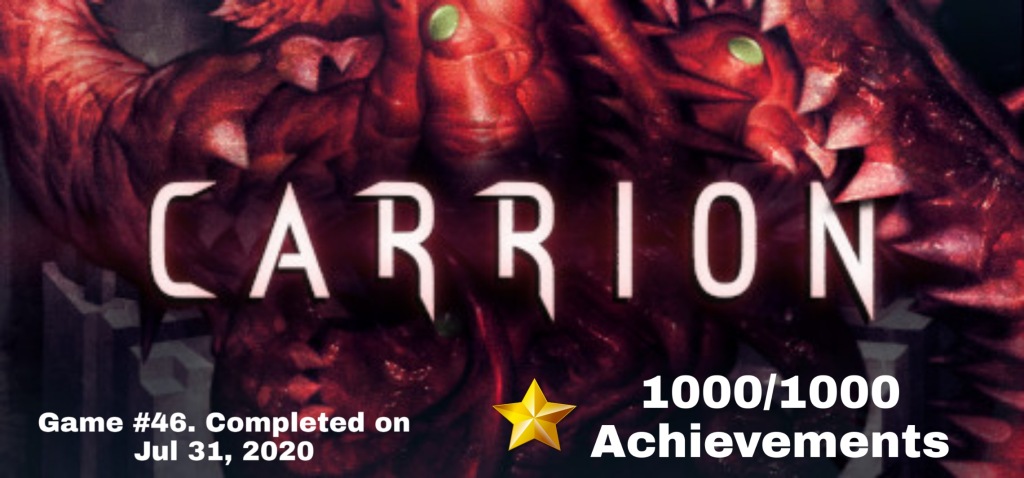
Carrion, developed by Phobia Game Studio, feels like you’re playing an entire game based around the final sequence from Playdead’s INSIDE. While Carrion is a 2D Metroid-like at its core, there’s no actual platforming. Instead, you control an unwieldy gelatinous blob as you wail around rooms causing havoc, destroying lab equipment, and other facilities, all the while eating scientists and soldiers wandering the halls of what appears to be an underground laboratory. It’s controlled chaos at its finest. There are save points scattered about the environment which restore health and allow you to spread your virus throughout the underground lab (in order to proceed). Visually, it’s very Stranger Things-like as your safe havens become nest-like enclosures that begin to eat away at the surroundings. It’s a very cool visual effect and cements the fact that you’re essentially a virus, spreading your corruption throughout the area.
Like any decent Metroid-like, you’ll gain new abilities that allow you travel to new parts of the lab and solve puzzles, some of which require you to remove parts of yourself as certain abilities are locked to particular levels of mutation. There are pools of special-looking water that allow you to dump a piece of your blob off in its waters, for example, which has an effect on the level of mutation you carry. While there’s no traditional map, the game’s rather linear so it’s not too difficult to get lost. The game does become a bit opened-ended towards the end, so some players have criticized the game for its lack of direction at times (despite there being digital signs pointing you in the right direction – most of the time). There are a handful of optional secrets areas/items to discover, which aren’t too difficult to track down, either. I completed the game at 100% with all of the Achievements unlocked. I really enjoyed my short time with Carrion and I’d love to see a more fleshed-out (pun intended) sequel.
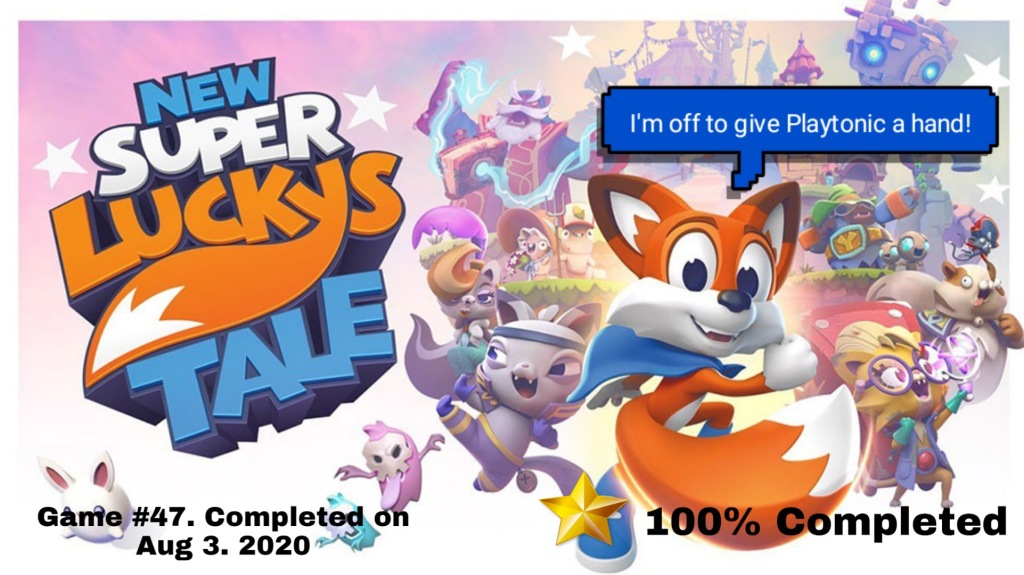
New Super Lucky’s Tale is a port of the XBOX ONE version only re-imagined and rebuilt for the Nintendo Switch (and now on PS4/XBOX One). It’s more than a port, however, as most, if not all of the levels have been retooled to take advantage of the new camera system and controls. Because of these fundamental changes, the game feels, looks and plays significantly different (better) than its previous entry. It’s still a relatively easy 3D platformer (outside of a handful of tricky post-game secret levels). Lucky, the fox, can run, double jump, and tale spin to attack enemies, but he’s also got a satisfying burrowing technique which allows the fox to burrow underground. The game does feel heavily inspired by Retro’s recent Donkey Kong Country games, however, specifically the 2D levels. While Lucky doesn’t have the same momentum or tightness in controls as the Kongs do, the levels feel noticeably crafted in their image, complete with hidden alcoves/walls that reveal secrets once uncovered.
I also can’t help but to compare the game to Playtonic’s Yooka-Laylee. Playful has arguably crafted a more competent, well-designed 3D platformer here than what the Rare veterans at Playtonic delivered, which feels somewhat ironic in hindsight. For two games about collecting pages for a magical book that leads to various worlds, it feels like Playtonic could learn a thing or two from Playful. Hopefully, more competition in the 3D platformer market makes for better games all-around moving forward. I completed the game at 100% with everything collected, too. I love this game so much that I’ll likely pick-up the PS4 version next year for a replay. I can’t wait to see what these developers do next.

Operation Logic Bomb: The Ultimate Search & Destroy (as shown on the box), developed by Jaleco, is a classic, top-down Run N’ Gun shooter that feels like an entire game made out of the overhead stages from Contra III: The Alien Wars. Every year, I try to balance my time with both old and new games, so I’m always looking for some retro titles I’ve never completed that I can reasonably finish in a sitting or two. Operation Logic Bomb is a relatively easy shooter with fun weapons, such as the classic Contra-like spread-shot and flamethrower), and short, somewhat non-linear stages. While the game does repeat boss encounters at times, they’re certainly the highlight of the game.
What’s interesting about the game is that while there’s no difficulty settings, you’re given 3 continues (if I recall my time spent with the game correctly) and unlike Contra, you actually have a health bar. The game’s environments are very samey, but the entire game is surprisingly interconnected, allowing you to backtrack through previous areas/rooms in order to progress once you unlock certain upgrades. It’s Metroid-like to a minor degree, but it’s definitely a bit more ambitious than your typical stage-by-stage design. I completed the game (with no save states!) through the Nintendo Switch Online offering after a few attempts and it honestly felt really good. Sometimes you need to ground yourself by playing old-school games legit and you could definitely do worse than Operation Logic Bomb.
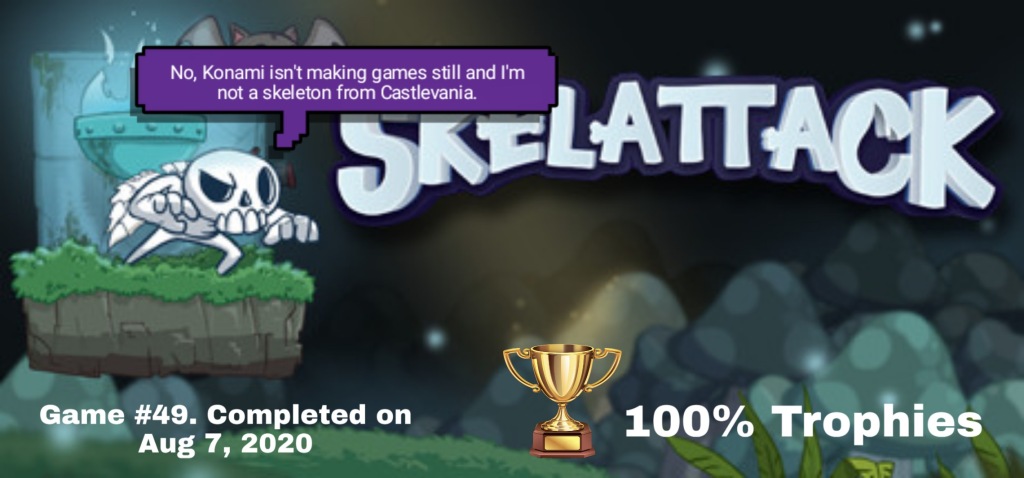
Skelattack, developed by Ukuza, Inc., is a 2D Metroid-like that’s not the Castlevania game you’ve been hoping for. This game had an interesting launch that’s worth noting. On the day of its release, the game was met with many people on social media screaming, “Konami makes games again!?”. Unfortunately, they still don’t and they were only the publisher for this indie title. In Skelattack, you play as a skeleton accompanied by a bat companion, who are on a quest in the underworld to stop humans from invading their realm. To my surprise, the game has a great story with some really good heart-felt writing, especially between the two protagonists. Your skeleton can run, double jump, cast spells and even use his bat friend to navigate certain obstacles. With that said, Skelattack is a very punishing game. While the checkpoints are in abundance, there are 1-hit kill hazards littered throughout the environment, which can cause a ton of frustration.
Skelattack almost feels like something designed for the speed-running/Twitch community. It’s also probably the most brisk, 4-5 hour experience I’ve had all year. You will die constantly but re-spawning is almost an instant, so you’ll find yourself saying “just one more try”. Before you know it, the game is over. My biggest pet peeve was the fact that the game locks you in a room right before the final boss and it auto-saves there. There’s no way to go back to the hub to upgrade, explore or do anything else after you complete the game. All of the game’s trophies are unlocked by just playing through the game, so it’s not a big deal, but still disappointing since there were lore book entries I collected that I never read and an upgrade or two I never found. So, outside of that, it was a relatively enjoyable experience and I’d love to see the developer try something again in the near future.
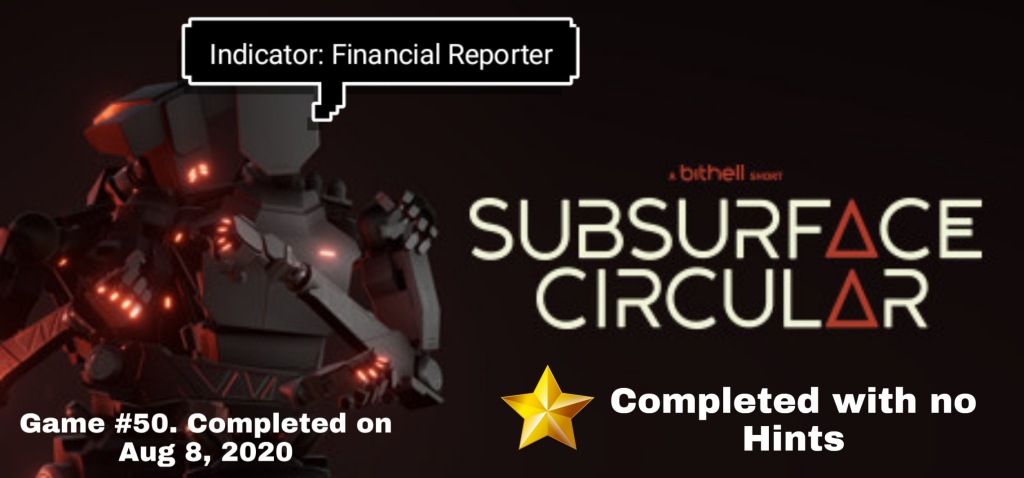
Mike Bithell’s Subsurface Circular is a post-apocalyptic, short-story/visual novel about a world full of humans and robots called “Teks”. The entire game takes place on a subway train on a circular path, which doesn’t sound too exciting, right? The game excels in its writing/narrative, however. As soon as you sit down and listen to the first passenger’s story, you’re hooked. There’s dialogue trees and simple puzzle-solving at play here by discovering key words in order to trigger new conversations. Without spoiling anything, the game’s essentially a murder-mystery story focused on missing Teks. Teks have rolls (called “Indicators” in the game), and they’re essentially jobs assigned to them like a career/profession a human would pursue (If I were a Tek, my indicator would unfortunately be a financial reporter in this game’s world, for example).
The less I say about Subsurface Circular, the better. If you love sci-fi narratives with political/real-world allegories, look no further than Subsurface Circular. It’s a couple hours long, but it’s a good read to pass an afternoon. I completed the game in a sitting or two with no Hints needed. I played Bithell’s Thomas Was Alone for the first time earlier this year and finally came around to it. I still need to play Quarantine Circular (given the state of the world, maybe I shouldn’t) and eventually his latest title, The Solitaire Conspiracy. Call me a fan to say the least.

Xeno Crisis, by Bitmap Bureau, is an overhead, rogue-light, Run N’ Gun shooter in the same vein as Smash TV. It first originated as a Kickstarter project destined for the Sega Mega Drive/Genesis, but it’s also now on PC/Steam and Xbox platforms. Xeno Crisis is a tribute to the games of yesterday and it really doesn’t waste your time getting started; aliens have invaded a military base and it’s your job to exterminate them all. That’s it. There’s 7 levels with procedural room generation littered with hordes of monsters that storm the player from entrances/exits and holes in the ground. There are random weapon drops (the laser is the best), ammunition, grenades and health items to stave off the hordes, but if you’re not quick on your feet (and your roll maneuver does have invincibility frames!), you’ll get bulldozed in a heartbeat. The game does have local-coop and I’ve heard it’s a lot easier due to the ability to revive your partner, but I can’t speak to this since I only played single-player.
The soundtrack is phenomenal, too. Every time I would fail a run of the game, the music in the first few stages would keep me motivated and moving forward. It’s the ultimate “…just one more try…” game. Xeno Crisis was one of the most satisfying arcade-like experiences I’ve had all year. Digital Foundry also did a wonderful developer dive into the making of the game that speaks to its quality. Finally, one of the coolest (but certainly unfair) aspects of the game is the fact that if you use a continue, you’ll never see one of the real endings. The developers tied this into the story/narrative as well, but it’s certainly an unforgiving prospect, even on Easy difficulty (which feels like Normal). I completed the game on Easy difficulty in a single credit and loved every second of it. If I had the energy/willingness that I had in my younger years, I’d be playing this nonstop until I mastered it on the highest difficulty available. Despite officially releasing in 2019, it’s one of the best games I played in 2020, hands-down.
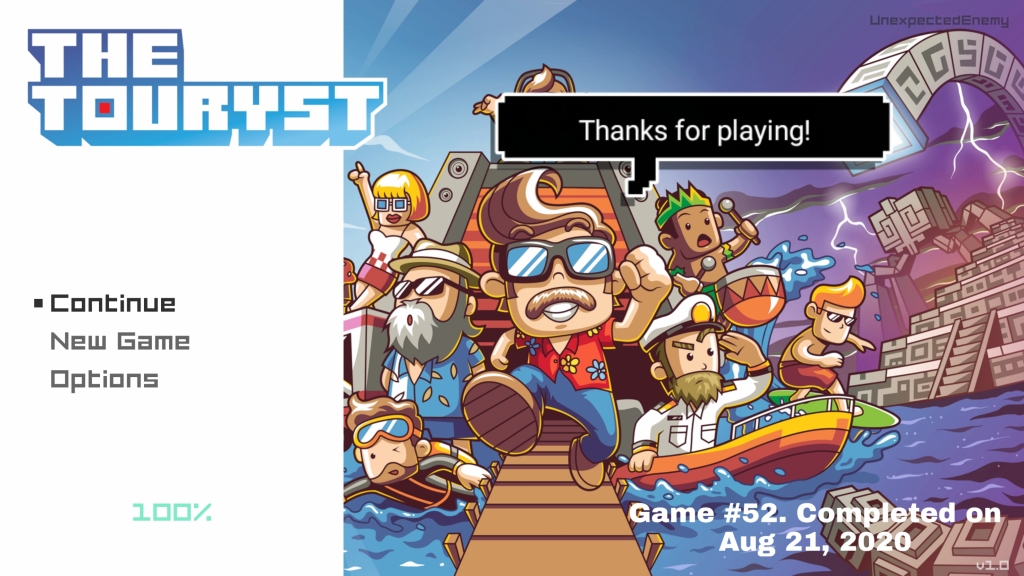
With the release of Shin’en Multimedia’s The Touryst on Xbox platformes, I decided to replay the game on Xbox One X (which is now further optimized on Xbox Series X) and completed it at 100%. I played this on the Nintendo Switch last year for the first time and wrote about it to a degree, so check out my 2019 GOTY post if you want to see what I had to say. Spoilers… it’s still one of my favorite games of all time and I can’t wait for a sequel or a new game from this studio.
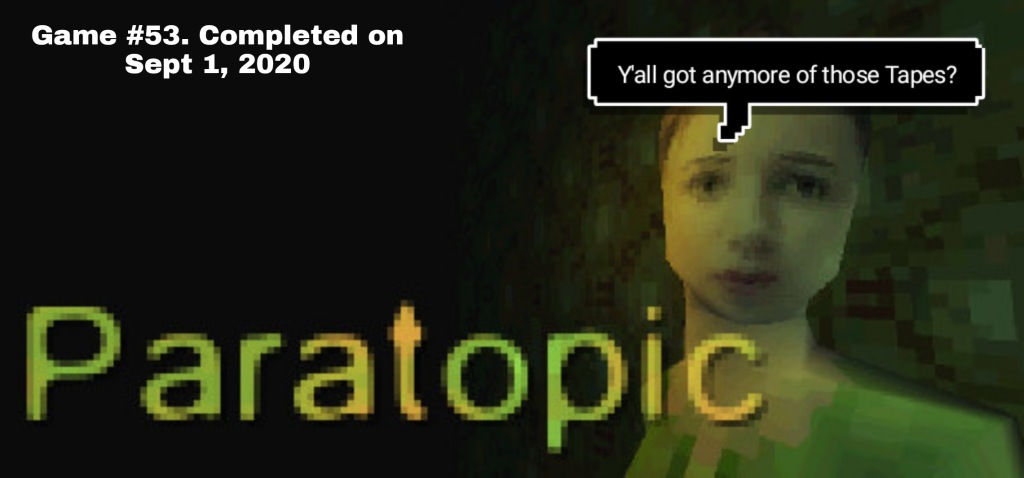
For the past few years, during the month of October, I would try to play as many horror-themed games as I could. 2020 has been horrifying enough, however, so I wasn’t particularly in the mood this year. With that said, I did manage to do a quick play-through of Arbitrary Metric’s Paratopic, a first-person psychological thriller, in the same vein as Variable State’s Virginia. This game is incredibly short and can be completed within an hour or so. It’s definitely a bizarre game about finding and delivering cursed tapes, I think? It’s purposely cryptic and strange, but it’s got that small-town, suburban horror vibe that’s hard to capture and I liked it for that reason alone. There are a handful of in-game achievements to earn based on some of the decisions you make along the way, but it certainly doesn’t overstay its welcome. Check it out if you’re in the mood for a short slice of horror and the mood strikes.
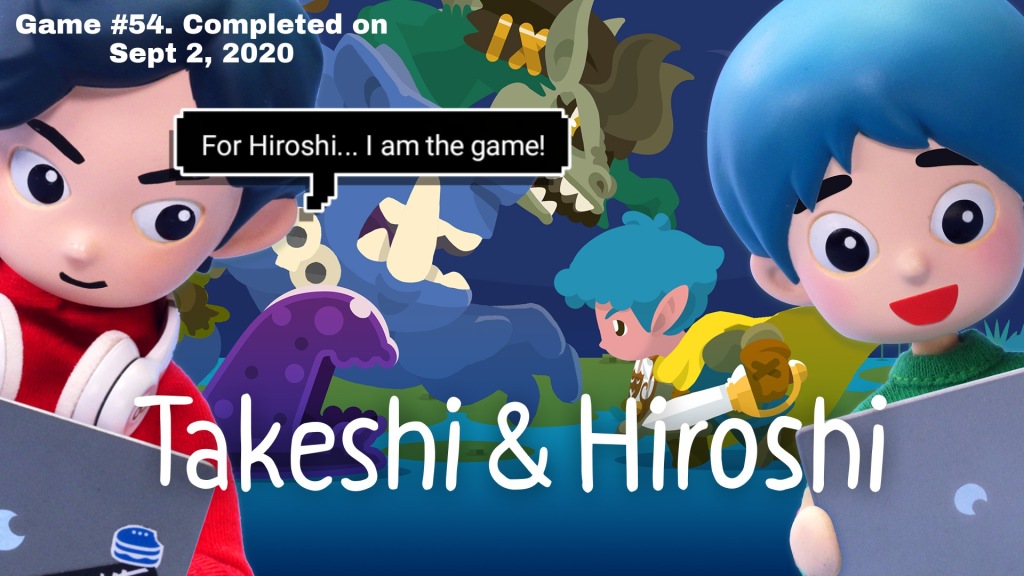
Oink Games Inc.’s Takeshi & Hiroshi is an adorable, heat-warming visual novel with some light, turn-based RPG combat. Previously released exclusively on Apple Arcade, Takeshi & Hiroshi, like many other indie titles, has made its way to the Nintendo eShop on the Switch. The game is about two brothers, one of which (the older brother) is developing his own game for his sick brother. The game being developed by the one, older brother is clearly inspired by Dragon Quest, but it certainly doesn’t play like one. What’s interesting about the story is that the brother has the ability to change certain aspects of the game in real-time while his sick brother “tests” the experience on his iPad-adjacent.
The combat portions of the game are actually extremely engaging. There are typically 5 rounds of combat set to an auto-scrolling 2D plane. You select a group of enemies for the “hero” to battle, some of which are weaker/stronger than others, and based on how much damage the “hero” takes, the little brother’s stress level will increase which in turn raises his enjoyment factor. In each level, you need to reach/break a certain “joy” threshold in order to proceed. The game keeps track of your high-scores and each stage can be replayed, although there really isn’t any incentive to improve your score (as there are no leader-boards).
The most notable aspect of the game, however, is its use of claymation for the cutscenes. It’s extremely well done and it’s impossible not to fall in love with the family, including the supporting characters who are charming in their own right. I enjoyed this game more than I thought I would and I honestly wanted more from it. You can complete this in a sitting or two and there’s not a whole lot of replay value, unfortunately. Back when episodic games were more popular, this game would have been prime real estate for mini-expansions/episodes. Nevertheless, it’s a lovely, playable Saturday morning cartoon that’s well worth your time. For Hiroshi… I am the game!
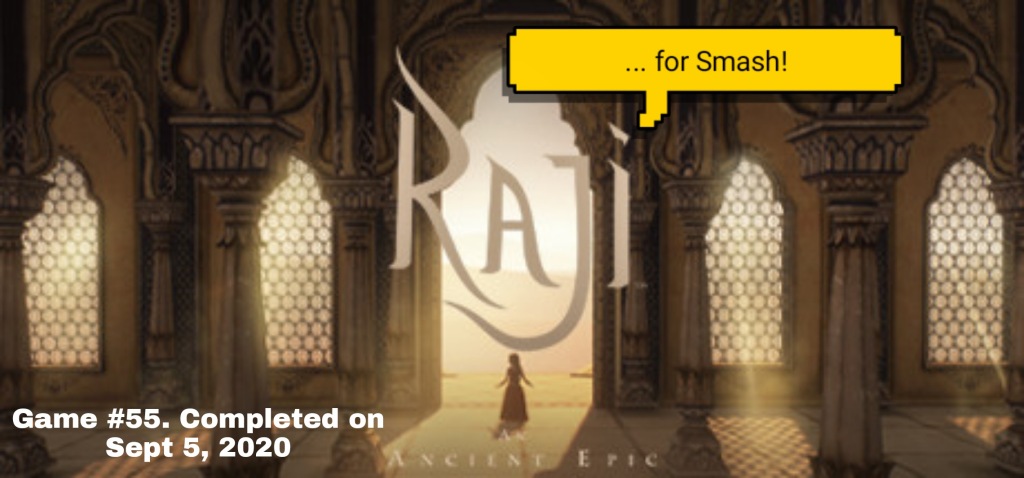
Raji: An Ancient Epic, by Nodding Heads Games, is an action-adventure game which takes place in ancient India. The game seems mostly inspired by PS2 era action games like God of War, Devil May Cry and Prince of Persia, for example. The game started out on Kickstarter, but failed to meet its initial goal. According to the developer, Raji had an extremely difficult development cycle. At the time of writing this, however, the game is now available on most, if not all major platforms. At first-glance, you’d be surprised to find out that Raji was an indie title made by a team of less than 20 people. It may look like a mid-tier “AAA” action-adventure game from afar, but the architecture, set-design and geography feels like something designed by a group of veterans. It feels like each statue, pot, rug or background material was meticulously placed with purpose and care. Aesthetically, it’s stunning to say the least.
It’s also exciting to see more games being developed in less-represented regions of the world; showcasing culture, mythology and tales we’ve rarely see in gaming. The story is rather simple and straightforward; Raji is on a quest to find her younger brother who’s been kidnapped by demons. Along the way she’ll be granted new powers, weapons and abilities by the gods in order to combat the hordes of monsters being sent her way. Raji is a rather linear game with some simple puzzle-solving sprinkled throughout its many combat arenas. Fighting enemies isn’t the most satisfying aspect of Raji, unfortunately. While you can dodge/guard attacks and cast spells, I often found myself button smashing my way through encounters or constantly running up walls/polls to perform overpowered aerial attacks. The combat, while serviceable, leaves a lot to be desired, but it’s still rather impressive for an indie studio’s first attempt.
I impulse purchased the Nintendo Switch version at launch (not realizing it was going to be ported to other, better performing hardware in the near-future) and it was somewhat of a struggle to play due to its performance issues, so that might be the main reason why I didn’t enjoy the combat scenarios. Raji does not run well, AT ALL, on the Switch. With that said, the allure of the game was too strong and I found myself unable to put it down until I completed it. After beating the game, your save file is overwritten and you start at the beginning again with no new upgrades/unlocks (which is sort of a bummer). I’m tempted to try the PS4/Xbox One versions sometime next year to see how it fairs compared to the Switch, but I enjoyed my time spent with it nevertheless. These developers certainly have a bright future ahead of them and I can’t wait to see what they do next.
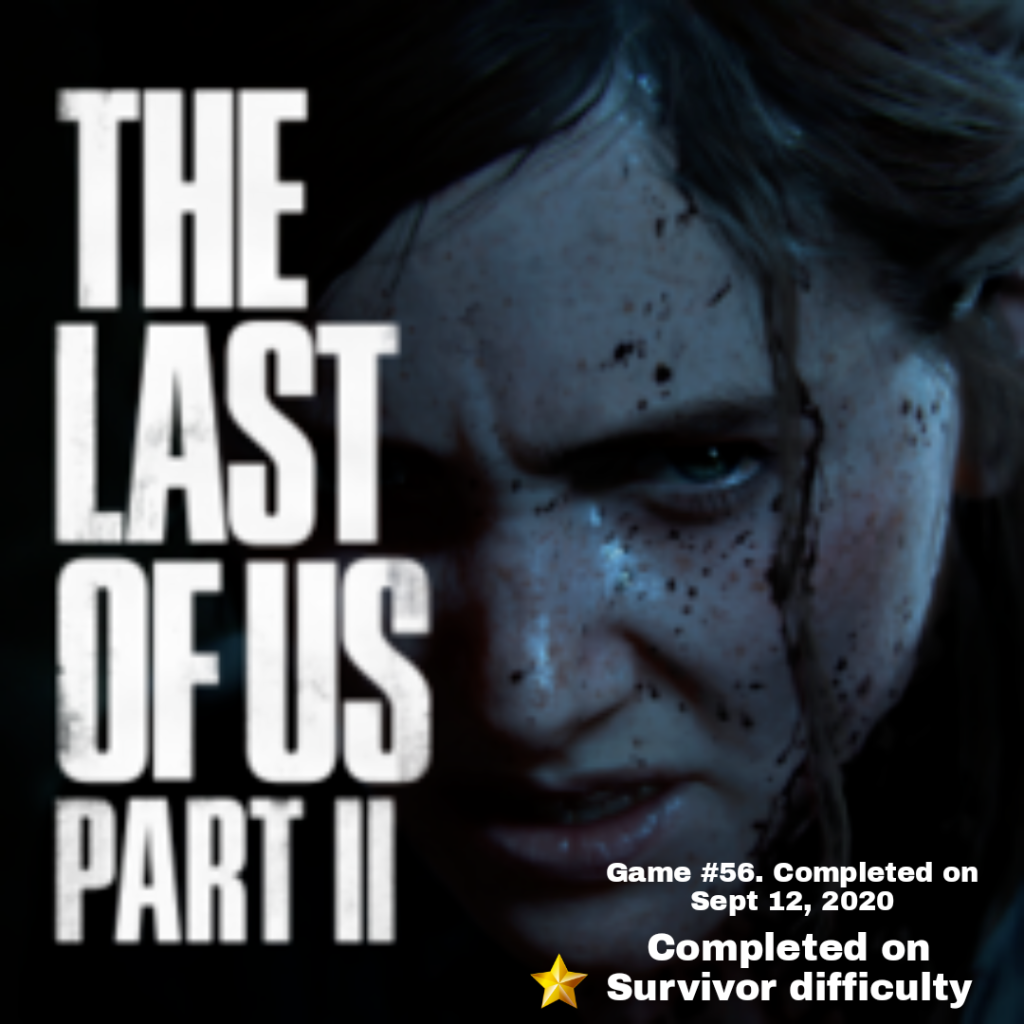
It took me a long time to get around to The Last of Us for a variety of reasons (which you can read about here), but I played through The Last of Us: Part II over the course of a few months and I have a lot to say about it now that I’ve seen everything to its conclusion.
Without spoiling major plot-points, The Last of Us: Part II was essentially a game about making you feel like shit no matter who’s perspective you were playing from. There’s nothing feel-good about this game and while I do believe it’s a worthy follow-up to the original, it’s probably something I’ll never want to play again for a very long time. It’s been a horrifyingly depressing year as it is, so watching these characters torture themselves over misguided anger/revenge isn’t exactly what I would call a good time. With that said, the game itself was extremely well-made. It’s beautifully shot with an all-star cast and it had some of the best, most memorable gameplay moments I’ve experienced all year.
If there’s one thing Naughty Dog does well with their post-Uncharted titles, it’s the illusion of choice and the subversion of your expectations. The Last of Us: Part II is still a campaign-driven, chapter-by-chapter, 3rd-person shooter at its core, but it’s definitely more ambitious and larger in-scope compared to their previous games. Many of the environments/areas offer multiple paths, even though they ultimately lead to the same destination. It’s this illusion of chase that makes your surroundings feel more believable/organic, which is something the original game did to an extent, too. Then there’s spaces like Seattle Day 1, or what I’d like to call, The Last of Us: Part II’s “God of War 2018/Breath of the Wild” moment.
After the prologue, as Souls fans would say, “…the true Last of Us: Part II starts here…”. As you’re galloping through a lush, dense forest with Dina on horseback (I swore I was playing Dino Crisis 2 for a moment as I fully expected a raptor to jump out at me from the tall grass), you ride out of the thicket to a vista that nearly captured the feelings I got when I first paddled out to the Lake of Nine in God of War 2018 or when I emerged from the starting shrine in Breath of the Wild. What’s super interesting about this section is that it’s the first (and only) time in the game where you have pure freedom to do as you please. There are non-linear objectives and landmarks calling for your attention in every corner of this field. If you do choose to partake in these side excursions, you’re greeted to great world-building and characterization between the two protagonists.
It’s the small details that go a long way during Seattle Day 1, too. Ellie will pull out a map and checkoff areas you’ve explored as you progress and they even implemented the organic conversation system that God of War 2018 had when you get on and off the boat mid conversation (in this game’s case, it’s a horse). Unfortunately, there really isn’t an area like this anywhere else in the game. I honestly wanted to see more chapters structured like Seattle Day 1, but the rest of the game is still rather linear. While it seems unavoidable, there are parts of The Last of Us: Part II that feel somewhat dated still. You’ll encounter a ton of “walk & talk” moments (made notorious by the Gears of War games) where certain parts of the scene feel caged-off, which is what I like to call the “zoo effect”. In the introduction, there’s an NPC in a greenhouse who’s pouring an endless amount of water from a bucket over some crops. It’s not the end of the world by any stretch of the imagination, but for a game so rooted/grounded in realism, moments like this certainly break the immersion factor.
The Last of Us: Part II is probably my favorite Naughty Dog game in terms of mechanics/playability, next to the original Jak & Daxter. It just feels good to play. The Last of Us: Part II is very long, but because it’s a much bigger game, there’s far more room to breathe, so-to-speak, when it comes to the combat options/opportunities at your disposal. The game still utilizes a pretty standardized upgrade/skill tree, but everything feels viable and more interesting to engage with due to the abundance of enemy encounters and the openness of the environments. With the inclusion of a jump button, there’s even light platforming now (and rope swinging, too) which makes the game feel more adventurous. It’s arguably runoff/carryover mechanics from the Uncharted titles, but they’re certainly welcome here.
As I mentioned earlier, the game does a wonderful job of subverting your expectations during combat scenarios. There’s one moment where you’ll approach a workbench to make some upgrades to your weapons (which is something you’ve done countless times prior to this encounter) and just as you’re about to open the crafting menu, an enemy rushes you from behind and pulls you out of the menu in attempt to ambush you. In another instance, there’s an unsuspecting door blocking your way and just as your about to open it, an axe-wielding brute busts through the frame. There’s numerous moments like this and they’re some of the most memorable gameplay experiences I had with the game.
Stealth just feels right in this game, too. It’s somewhere between Hitman and Metal Gear Solid (MGS) yet it’s extremely satisfying. Enemy patrols will spot you, check the area appropriately, and they will call out to others by name (which reminds me of how each soldier in MGS2, for example, had individual dog tags with unique names). Human enemies will check corners and ambush you if you’re hiding behind cover, which also interrupts your potential stealth-kill animation. There are no longer expendable shivs (for Ellie, at least), which makes the combat-loop feel more forgiving. It may have been my imagination, but it also felt like her throat-slitting animation became quicker/more efficient overtime, which would have been an organic way to signal to the player that she’s getting better at, I don’t know, murdering people? Glass breaking is also super satisfying and tossing a brick/bottle and rushing towards the enemy to grab/strike them is a wonderful (yet brutal) feeling.
Speaking of enemies, monsters and the infected, there were (finally) new enemy types as well! The dogs were an interesting/welcome addition, despite how immoral it felt to let them track your scent to a trip-mine you so conveniently placed around the corner. There’s the “Stalkers” too, which I believe were a cross between traditional runners and clickers; they were probably in the original game, but they appeared to act differently in the sequel. The barbarian, tribal-like cult (the Scars) used whistling for communication during combat. My favorite gameplay touch, however, was when all of the enemies were defeated in an area, the characters would comment on how the area has been cleared, letting the player know that they can finally rest and explore without hesitation.
Finally, as a gay man who’s been out for almost 4 years now, there’s a scene that struck a chord with me early-on involving Ellie, Dina and her ex-boyfriend, Jesse. Dina reveals to Ellie that’s she pregnant from her ex, but when Ellie returns with Jessie to their secret hideout, Dina’s shocked to see that he’s been injured. Dina pays more attention to him and comes off as being more concerned about him than she is for Ellie (despite also having some sort of on & off relationship with her). Ellie’s reaction, and the way she walks off from the scene, really stuck with me. For whatever reason, this scene reminded me of how I navigated my current job of eight years as a gay man.
I’ve had crushes on straight men I’ve either worked directly with or met in passing at my place of business. These men were co-workers and the like, but I would never pursue anything for obvious reasons. The way (I think) Ellie felt in this moment was a reflection of how I felt when a lot of these men’s wives/girlfriends would show up at work. For a long time prior to coming out, I had built-up some sort of false, non-existent potential relationship in my head with some of these men. It was some sort of future that wasn’t real and it was incredibly depressing/defeating, to say the least. It was an imaginary “chase” that I had to talk myself out of over time and it’s something I’d like to think Ellie felt during this moment.
See you next quarter and for the GOTY post!
-Matty
1 Comment »